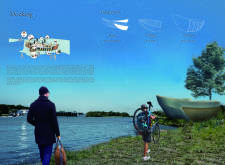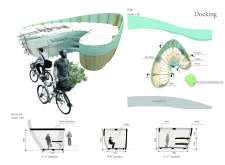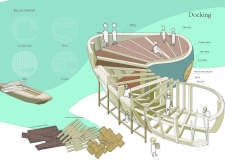5 key facts about this project
The litro Velo 6 route is designed to connect cyclists with the historical pathways of the Loire and Danube rivers. This cycling path serves not only as a route for transportation but also as an engaging experience that highlights the stories of trade and community that have defined these waterways for generations. The design concept draws inspiration from the experience of being inside a ship, bringing historical context to life for modern users.
Historical Context
The project embraces the rich history of trade that took place along the Danube and Loire rivers. By recreating features reminiscent of a ship's cabin, the design allows cyclists to feel a sense of connection to the maritime heritage of the region. This approach encourages users to share stories and engage with one another as they travel, reinforcing the importance of community along these historic trade routes.
Material Use
Recycled materials play a significant role in the construction of the route. The design incorporates reclaimed wood planks sourced from countries along the Danube River, reflecting a commitment to sustainability. Additional materials include wooden stakes, barrels, Zillens, which are traditional wooden boats, and straw blocks from local farms. This choice of materials contributes to the broader narrative of the project, showcasing local craftsmanship and environmental awareness.
Functional Design
The layout includes various functional spaces tailored to meet the needs of cyclists. Areas for bike racks and communal tables are carefully organized, supporting different activities along the route. This design not only meets practical requirements but also promotes social interaction among users. It creates a welcoming environment for cyclists, making it clear that the space is meant for gathering and sharing experiences.
Incorporated Details
Architectural elements that evoke a ship's design enhance the overall theme of the project. The use of wood and thoughtful spatial organization speaks to the maritime history and cultural significance of the rivers. As cyclists travel along the route, they are invited to immerse themselves in the stories that shape the identity of the region. Each detail comes together to create a cohesive experience that celebrates the tradition of trade and community along these important waterways.






















































